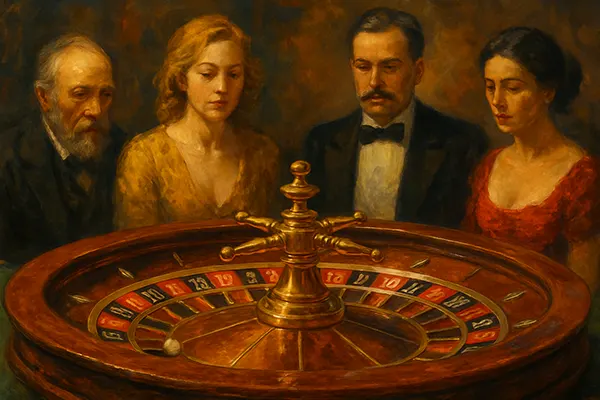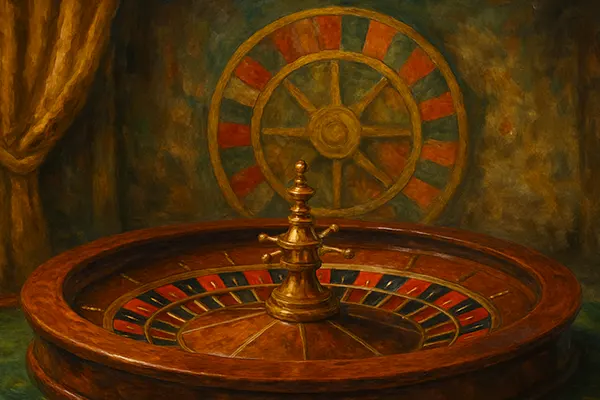
The Art of Roulette: Visual Interpretations of the Wheel of Fortune in Painting and Cinema
The roulette wheel has become a lasting artistic symbol that merges ideas of fate, unpredictability and the fragile balance between decision and chance. Across centuries, painters and filmmakers have used circular imagery to examine the patterns and contradictions of human experience. This article follows the evolution of this symbol, analysing how roulette and its artistic relatives appear in visual culture and how they reveal deeper reflections on uncertainty.
Roulette as a Modern Expression of the Ancient Wheel of Fortune
The medieval figure of Fortuna turning her wheel influenced generations of European artists, forming the conceptual foundation for later interpretations of roulette. Visual works by painters such as Taddeo di Bartolo or the anonymous illustrators of the 15th-century “Wheel of Fortune” manuscripts often presented life as a cyclical rise and fall. These early depictions shaped the symbolic language that later creators would reinterpret through contemporary imagery.
When roulette became known in the 18th and 19th centuries, artists began to associate it with the same philosophical ideas that surrounded Fortuna’s wheel. The circular motion of the ball reflected a universe where predictability remains limited, and where circumstances can rapidly shift. Painters of the Belle Époque, especially those illustrating casino salons of Monte Carlo, incorporated these analogies to critique social inequality and moral conflict.
By the early 20th century, roulette appeared in artworks not merely as a gambling motif but as a representation of a society confronted with industrial transformation. Artists explored themes of anxiety, rapid change and the collapse of traditional hierarchies. The wheel became an emblem of a world losing its sense of stability.
Pictorial Examples of Fate and Cycles in Painting
Jean Metzinger’s Cubist works, while not always depicting roulette directly, explored fragmentation and circular movement in ways influenced by modern gaming culture. His interest in mathematical structure mirrored the logic of probability associated with roulette. The sense of shifting angles and outcomes created a link between artistic experimentation and the unknown results of a spinning wheel.
Another example appears in the Art Deco period, where illustrators often presented roulette tables as glamorous yet precarious environments. Artists such as Georges Barbier and Erté used dynamic lines and intense contrasts to show elegance set against uncertainty. Their compositions highlighted how easily comfort could transition into loss, echoing the ancient symbolism of fluctuating fortune.
Contemporary painters continue to reinterpret roulette as a commentary on economic and personal instability. Modern abstract works often use circular geometry and chromatic rotation to depict patterns of choice and unpredictability. This symbolic vocabulary persists because the idea of the wheel resonates with modern concerns about control and randomness.
Cinematic Interpretations of Roulette and Destiny
Roulette became a powerful cinematic motif during the mid-20th century, appearing in films that examined tension, ethics and transformation. Directors used the table not only for dramatic impact but also to illustrate the unpredictability of human motives. The wheel’s motion offered a visual shorthand for risk and internal conflict.
In the 1942 classic “Casablanca”, the roulette table plays a crucial narrative role. Rick uses it to help a young couple secure a future, demonstrating how human agency interacts with chance. The scene contrasts personal choice with the wheel’s indifference, reinforcing the duality between intention and circumstance.
Later films such as “Run Lola Run” (1998) used game imagery and probabilistic sequences to show how slight variations in events can alter outcomes. While roulette is not always shown directly, the language of randomness and repeated cycles operates on the same conceptual foundation, illustrating how cinema continues to reinterpret the idea of rotating destiny.
Iconic On-Screen Moments Involving the Wheel
Martin Scorsese’s “Casino” (1995) includes detailed portrayals of roulette tables, capturing the rhythm and collective anticipation surrounding each spin. Although the film focuses on the operational dynamics of a gambling institution, the wheel symbolises the fragile balance between control and collapse. Its presence reflects the volatility of personal ambition.
In “The Deer Hunter” (1978), the controversial Russian roulette scenes, though representing a different and tragic form of chance, reinforce the idea that a single turn can change everything. The scenes use circular imagery to demonstrate how randomness generates severe psychological pressure. This comparison highlights how the wheel metaphor extends beyond gaming into broader cultural contexts.
Modern animation also draws on roulette imagery. Productions from major studios occasionally incorporate spinning mechanisms or symbolic wheels to represent decision points or character dilemmas. These sequences show how the visual language of roulette continues to inspire contemporary creators across genres.

Roulette as a Contemporary Cultural Symbol
Artists of the 21st century increasingly use roulette in works that address economic instability, technological change and the unpredictability of global events. The wheel appears as a metaphor for modern society, where individuals navigate uncertain markets, shifting politics and rapidly evolving digital environments. Its symbolism remains relevant because the experience of unpredictability persists.
In digital art installations, rotating discs and algorithmic randomisers often mimic the mechanics of roulette. These pieces explore how randomness shapes data, behaviour and decision-making. By linking ancient symbolism with modern technology, artists highlight the tension between human intention and automated processes.
Roulette imagery also appears in contemporary photography, where circular patterns and reflective surfaces are used to explore personal identity and emotional turbulence. Photographers utilise these motifs to examine the fragility of long-term plans in an unpredictable world, preserving the symbolic strength of the wheel in new formats.
Recent Artistic and Multimedia Interpretations
Mixed-media exhibitions from the early 2020s and 2025 often present roulette as part of broader discussions about chance and societal transformation. Artists employ kinetic sculptures, light projection and interactive elements to show how cycles of cause and effect influence everyday choices. These installations place visitors in environments where outcomes shift continually.
Modern illustrators, especially those working in graphic novels, present roulette as a visual shorthand for difficult decisions. Circular frames or recurring spinning motifs draw attention to moments where characters confront uncertainty. This reinforces the continuing influence of roulette as a narrative tool.
Virtual-reality creators have also adopted wheel-based metaphors, designing environments where users encounter branching paths shaped by probabilistic rules. These experiences reflect the enduring appeal of circular symbolism and its ability to convey the delicate interplay of structure and unpredictability in contemporary life.
